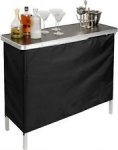tim292stro
Well-known member
- 2,118
- 41
- 48
- Location
- S.F. Bay Area/California
9U Hardigg case is on its way, just a hair under $200 (shipped) for a $2,200 case.

Also, I picked up another ToughBook mobile docking station, that I will "gene splice" into a sliding rack mount shelf to house the ToughBook running Asterisk, VPN, Web-Proxy, and the 2G/3G/4G modem. I'm probably going to pick up another Hardigg transit case to put VoIP phones and workstation ToughBooks in to make moving them more manageable, when empty it'll give me something to put the rack case on while it's being used so I can get it up off the ground.
In the mean time I'm also working on the package design for the 3U LiFePO4 UPS I'm building, this will be the stand-alone power source for the tent lighting, which can also accept 120/208/240VAC (single phase) and 12/24VDC charging input, as well as a solar input up to 110VDC.

Also, I picked up another ToughBook mobile docking station, that I will "gene splice" into a sliding rack mount shelf to house the ToughBook running Asterisk, VPN, Web-Proxy, and the 2G/3G/4G modem. I'm probably going to pick up another Hardigg transit case to put VoIP phones and workstation ToughBooks in to make moving them more manageable, when empty it'll give me something to put the rack case on while it's being used so I can get it up off the ground.
In the mean time I'm also working on the package design for the 3U LiFePO4 UPS I'm building, this will be the stand-alone power source for the tent lighting, which can also accept 120/208/240VAC (single phase) and 12/24VDC charging input, as well as a solar input up to 110VDC.
Last edited:













